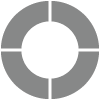Build Your Canvas
The report canvas is your chance to decide how to best display your results. When you generate your default Omni Report, you’ll find a blank canvas tab ready and waiting. Access the report canvas by clicking on the ‘Untitled Canvas’ tab at the top of the screen.
This feature is available only in our Enterprise plan. Contact us to take advantage of this option.
Navigate to
- Add Canvas Content
- Rearrange Elements
- Customize Canvas Settings
- Modify Canvas Content
- Remove Canvas Content
- Email Your Canvas
- Report-Level Segmentation
- Time Trend
Add Canvas Content
To build your report canvas, you may:
- Add the entire report to the canvas. Just click ‘Add Report to Canvas’ at the top of the default report screen.
- Add an individual question to the canvas. Just hover over the question and click the ‘Add to canvas’ icon.
- Add the graph or data table from any question, or multiple graphs or data tables from a single question. Just hover over any graph or data table, click on the three-dot menu that appears, and click ‘Add to Canvas’.
- Add Survey Metrics to the end of the report canvas. Just click on Survey Metrics at the top of your default report, hover over and select any items to include, then click ‘Add To Canvas’.
- Add a customized report canvas name by clicking on the default title [Untitled Canvas] and entering new text.

Rearrange Elements
- To rearrange questions, individual graphs and data tables, click Rearrange Elements in the top right of the canvas.
- Drag and drop questions into the desired order.
- To rearrange the graphs and data tables of individual questions, click Expand All in the top right. All graphs and tables of all questions added to the canvas will be displayed.
- Rearrange graphs and data tables by dragging and dropping them into the required position.
- To save, click Apply.

Customize Canvas Settings
Customize the complete canvas by clicking on the settings icon at the top right of your canvas and selecting Canvas Settings.
- Display questions: Check/uncheck to show/hide question text on the canvas
- Display filter details: Check/uncheck to show/hide any details about any filters applied to specific questions or the overall report
- Display response setting details: Check/uncheck to show/hide any details about changes made to any answer option in the default
- Do not show questions with 0 responses: Check/uncheck to show/hide any questions that have not received any responses
- Add Cover Page: Check/Uncheck to add a Cover Page for your Canvas

Modify Canvas Content
- To add a footnote for a graph or table, hover over it, click on the three-dot menu, click Add footnote, and enter text in the box that appears below. Remove the footnote by returning to the same menu and clicking Remove footnote.
- To hide a question group header, hover over a related graph or table, click on the three-dot menu, and click ‘Hide question group header’. Display it again by returning to the same menu and clicking ‘Show question group header’.
- To hide filter information, hover over a graph or table, click on the three-dot menu and click ‘Hide filter information’. Display it again by returning to the same menu and clicking ‘Show filter information’.
- Click Add Slides, found on the top of the Canvas, to insert information between charts ang graphs. Enter a title and description for each new slide, then click Rearrange to insert the new slide in the appropriate order.

Remove Canvas Content
- To remove a specific graph or data table, hover over it, click on the three-dot menu, and click Remove.
- To remove a Survey Metrics item, hover over it, click on the three-dot menu, then click Remove.
- To remove all content, click on the Clear All link at the top of the page.

Email Your Canvas
The Omni canvas provides a go-to dashboard to review your report, and it’s easy to share with key team members. Rather than downloading and sending static content over and over again, send a dynamic link that updates automatically with the latest information.
- To share your canvas via email, click on the email icon in the top-right corner of the canvas.
- Fill in the following details:
- Report Title: Enter a unique title for your report.
- Sender Name: Enter the sender’s name. By default, this value will be the name on the account.
- Sender Email: By default, this address will use Sogolytics’s mail servers. We recommend you use this default address, as editing this field may cause delivery issues or classification as spam. To change the Sender Email, you will need to verify your email address.
- Subject: Add a subject line that is clear and simple. The maximum character limit for this field is 250. By default, you’ll see Invitation to view Omni Report.
- To: Enter up to 10 email addresses that should receive the report canvas.

- Add a logo to the email content, if you wish.
- Select Show Export to show export options in the report generated
- Enter any content that should be included.
- Choose when to expire the report link delivered. By default, all emailed report are set to expire in 30 days.
- Apply any required color customization.
- Click Continue, preview the email, and send!
Report-Level Segmentation
Sometimes, all you need is an overall report, but sometimes you need to give each leader or team their own relevant slice of the data. For example, you might want to send each school’s results from a district climate survey to the appropriate principal. Enter Report-Level Segmentation! This option saves time by allowing you to segment a single report into all of the right slices – based on answers, metadata elements, or the conditions of your choice.
Here’s how:
- Within the Omni Canvas, click on the Report-Level Segmentation icon.
- Name the segment group (Department, Location, etc.) and choose the relevant segment question or metadata, then select the answer options that identify the segments to be generated. You may choose not to show segments with fewer than a certain number of responses.
- As required, you may choose to include in each report a comparison of segmented data dynamically based on:
- Answer to a particular question: The segmented data will be dynamically compared based on designated responses to a selected question (Ex: Employee in HR Department / Entire HR Department)
- Data from the entire project: Segmented data will be dynamically compared with responses of the entire project (Ex: Employee / Entire Company)

- While the data is being compared dynamically, you may choose to exclude the segments that are being viewed (Ex: Employee / Entire Company minus Employee)
Dynamic Comparison can be applied to trend graphs, trend tables, non-percent data tables, and non-percentage metric graphs.
- Click Done to continue.
- After a segment question is added, a dropdown will be displayed at the top of the report. When you select segments, the report below will update accordingly.
- To add more segmenting groups, click the plus icon and repeat the steps above. You may add up to 10 segment groups.
- To define the relationship between multiple segment groups, check the box in front of ‘Segment based on multiple segment groups’, then choose AND or OR from the dropdown between groups. AND means that both of the conditions must be met and OR means that either one of the conditions must be met.

- From the three-dot menu beside the dropdown menu, choose to:
- Edit: Opens the Apply Segmentation modal for modifying segment options.
- Share via Email: Opens the Share via Email modal. Select the segment group to be emailed.
- You can choose to send the combined result of multiple segments by enabling ‘Allow recipients to drill down based on other Segment groups’. This option allows you to select the operators between various segments. If there are more than two segments, in addition to the primary segment, the platform will default to performing an AND operation between the primary segment and the first segment. For subsequent segments, select either AND or OR operations.

- This feature also allows you to send each segment separately to different email addresses or map and send each segment’s data to email addresses on a Contact List. To protect participant confidentiality, you may choose not to share segments with only a few responses. When this option is chosen, the platform will only share segments that match your criteria.
- You can choose to send the combined result of multiple segments by enabling ‘Allow recipients to drill down based on other Segment groups’. This option allows you to select the operators between various segments. If there are more than two segments, in addition to the primary segment, the platform will default to performing an AND operation between the primary segment and the first segment. For subsequent segments, select either AND or OR operations.
- Export: Choose to export either the entire Canvas or only the segmented data in Excel, PowerPoint, or PDF formats. To protect participant confidentiality, you may choose not to share segments with only a few responses. When this option is chosen, the platform will only share segments that match your criteria.

- Remove: Removes the segment group.
Based on your display resolution or browser zoom, you may see a 3-dot icon on the far right of the Report menu bar. Click here to access Saved Reports, Emailed Reports, and Filter Manager.
Time Trend
Want to better understand how ratings are changing over time? Choose to review trends for rating and metric questions through both graphs and tables.
- Within the Omni Report, hover over the text of a rating/metric question and click on the three dots to the right.
- Select Show Trend. Based on the dates of all the responses, the system will plot the Trend graph. The line shows the trend and the bars in the chart show the breakdown of responses for each time period based on the selected frequency interval.
- Customize the display to present the data you’re interested in reviewing.
- To change the time period display, use the Frequency dropdown menu.
- To change the calculation display, click on the three dots to the right. From the Calculation dropdown menu, select your preferred display.
- Cumulative: Displays the cumulative data received up to a designated time.
- Non-Cumulative: Displays the score based on response received in the given time period (Day, Month, or Quarter).
- To change the representation type, click on the three dots to the right. From the Representation dropdown menu, select your preferred display.
- Graph: Display trend in a graph form.
- Show or hide the Bar Graph.
- Show or hide the Trend Line.
- Table: Display trend in a table form
- To highlight certain cells, click Conditional Formatting and define the colors and values for up to 5 conditions.
- Graph: Display trend in a graph form.
Conditional formatting is available for all trend tables.
Subscribe for tips and insights to drive better decisions!







